
Isaac Asimov was an American writer and professor of biochemistry at Boston University. During his lifetime, Asimov was considered one of the "Big Three" science fiction writers, along with Robert A. Heinlein and Arthur C. Clarke. A prolific writer, he wrote or edited more than 500 books. He also wrote an estimated 90,000 letters and postcards. Best known for his hard science fiction, Asimov also wrote mysteries and fantasy, as well as popular science and other non-fiction.
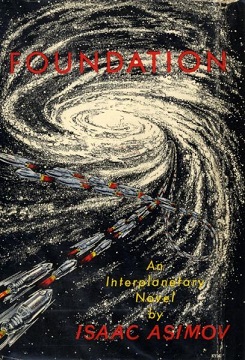
The Foundation series is a science fiction book series written by American author Isaac Asimov. First published as a series of short stories and novellas in 1942–50, and subsequently in three books in 1951–53, for nearly thirty years the series was widely known as The Foundation Trilogy: Foundation (1951), Foundation and Empire (1952), and Second Foundation (1953). It won the one-time Hugo Award for "Best All-Time Series" in 1966. Asimov later added new volumes, with two sequels, Foundation's Edge (1982) and Foundation and Earth (1986), and two prequels, Prelude to Foundation (1988) and Forward the Foundation (1993).

The Three Laws of Robotics are a set of rules devised by science fiction author Isaac Asimov, which were to be followed by robots in several of his stories. The rules were introduced in his 1942 short story "Runaround", although similar restrictions had been implied in earlier stories.

Nemesis is a science fiction novel by American writer Isaac Asimov. One of his later science fiction novels, it was published in 1989, three years before his death. This novel is connected to Asimov's other works by several ideas from earlier and later novels, including non-human intelligence, sentient astronomical bodies ("Hallucination"), and rotor engines.
"The Evitable Conflict" is a science fiction short story by American writer Isaac Asimov. It first appeared in the June 1950 issue of Astounding Science Fiction and subsequently appeared in the collections I, Robot (1950), The Complete Robot (1982), and Robot Visions (1990). It features the character Stephen Byerley from the earlier "Evidence".
This is a bibliography of the books written or edited by Isaac Asimov, arranged alphabetically. Asimov was a prolific author, and he engaged in many collaborations with other authors. This list may not yet be complete. The total number of books listed here is over 500. Asimov died in 1992 at age 72; a small number of his books were published posthumously.
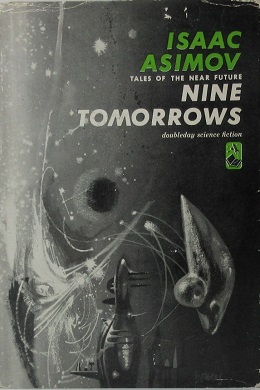
Nine Tomorrows is a collection of nine short stories and two pieces of comic verse by American writer Isaac Asimov. The pieces were all originally published in magazines between 1956 and 1958, with the exception of the closing poem, "Rejection Slips", which was original to the collection. The book was first published in the United States in 1959 and in the UK in 1963. It includes two of Asimov's favorite stories, "The Last Question" and "The Ugly Little Boy".

The Best of Isaac Asimov is a collection of twelve science fiction short stories by American writer Isaac Asimov, published by Sphere in 1973. It begins with a short introduction giving various details on the stories, such as how they came to be written, or what significance merits their inclusion in a "best of" collection, as well as some of Dr. Asimov's thoughts on a best of collection itself. The stories included are two of his early works, two of his late works (post-1960), and eight from the 1950s, which he refers to as his "golden decade" in the introduction. Except for the last story in the book, "Mirror Image", none of the stories are related to his Robot and Foundation series, while a few mention the Multivac computer.
"The Dying Night" is a science fiction short story by American writer Isaac Asimov. The story first appeared in the July 1956 issue of The Magazine of Fantasy & Science Fiction, and was reprinted in the collections Nine Tomorrows (1959), Asimov's Mysteries (1968), and The Best of Isaac Asimov (1973). "The Dying Night" is Asimov's third Wendell Urth story.

"Anniversary" is a science fiction short story by American writer Isaac Asimov. It was first published in the March 1959 issue of Amazing Stories and subsequently appeared in the collections Asimov's Mysteries (1968) and The Best of Isaac Asimov (1973).
Martin Harry Greenberg was an American academic and anthologist in many genres, including mysteries and horror, but especially in speculative fiction. In all, he compiled 1,298 anthologies and commissioned over 8,200 original short stories. He founded Tekno Books, a packager of more than 2000 published books. He was also a co-founder of the Sci-Fi Channel. Greenberg was also an expert in terrorism and the Middle East. He was a longtime friend, colleague and business partner of Isaac Asimov.
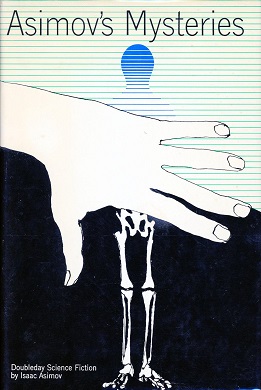
Asimov's Mysteries, published in 1968, is a collection of 14 short stories by American writer Isaac Asimov, almost all of them science fiction mysteries. The stories were all originally published in magazines between 1954 and 1967, except for "Marooned off Vesta", Asimov's first published story, which first appeared in 1939.
"The Talking Stone" is a science fiction mystery short story by American writer Isaac Asimov, which first appeared in the October 1955 issue of The Magazine of Fantasy and Science Fiction and was reprinted in the 1968 collection Asimov's Mysteries. "The Talking Stone" was the second of Asimov's Wendell Urth stories.
"The Dust of Death" is a science fiction/mystery short story by American writer Isaac Asimov, first published in the January 1957 issue of Venture Science Fiction Magazine and reprinted in the 1968 collection Asimov's Mysteries.
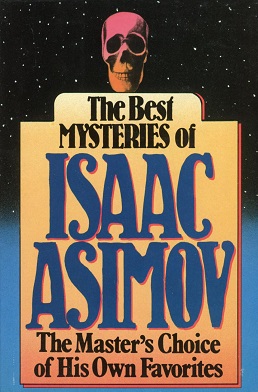
The Best Mysteries of Isaac Asimov is a collection of mystery short stories by American author Isaac Asimov. It was first published in hardcover by Doubleday in 1986, and in paperback by the Fawcett Crest imprint of Ballantine Books in September 1987.

The Asimov Chronicles: Fifty Years of Isaac Asimov is a collection of forty eight short science fiction and mystery stories and two science essays by American writer Isaac Asimov, published by Dark Harvest in May 1989.
"The Ultimate Crime" is a short story by Isaac Asimov, dealing with a minor aspect of one of the Sherlock Holmes stories of Sir Arthur Conan Doyle. It is the 24th of Asimov's Black Widowers mystery stories, and it appeared in his anthology More Tales of the Black Widowers, which collects the second dozen stories of the series. It was written specially for that book. It subsequently appeared again in Sherlock Holmes Through Time and Space, an anthology of stories written by different authors and co-edited by Asimov, and Another Round at the Spaceport Bar.
In a writing career spanning 53 years (1939–1992), science fiction and popular science author Isaac Asimov (1920–1992) wrote and published 40 novels, 383 short stories, over 280 non-fiction books, and edited about 147 others.
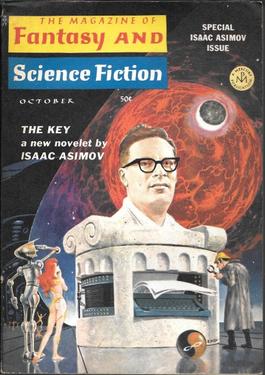
"The Key" is a science fiction mystery novelette by American writer Isaac Asimov. It is one of the stories featuring the reclusive scientist Wendell Urth. It first appeared in The Magazine of Fantasy & Science Fiction in October 1966, and was reprinted in the anthologies Asimov's Mysteries (1968) and The Best Mysteries of Isaac Asimov (1986).
Depending on the counting convention used, and including all titles, charts, and edited collections, there may be currently over 500 books in Isaac Asimov's bibliography—as well as his individual short stories, individual essays, and criticism. For his 100th, 200th, and 300th books, Asimov published Opus 100 (1969), Opus 200 (1979), and Opus 300 (1984), celebrating his writing.










